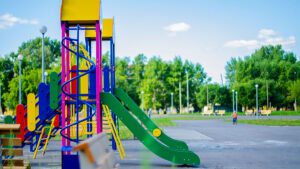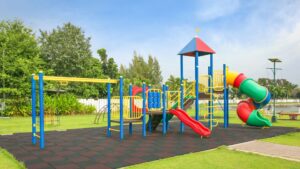Parks and playgrounds are essential components of vibrant communities, offering spaces for recreation, socialization, and connection with nature. While the terms are sometimes used interchangeably, parks and playgrounds serve distinct purposes and feature different amenities, safety considerations, sizes, locations, and costs. Understanding these differences can help community planners, parents, and park administrators make informed decisions about designing and maintaining outdoor spaces that cater to diverse needs.
1. What Is a Park?
A park is a public green space set aside for recreation, conservation, and community gatherings. Parks can vary widely—from small neighborhood pocket parks to expansive regional parks and nature reserves. Common features include:
- Natural Areas: Woodlands, meadows, ponds, and wildlife habitats.
- Walking & Biking Trails: Paved or unpaved paths winding through the landscape.
- Sports Facilities: Soccer fields, baseball diamonds, basketball courts, tennis courts.
- Picnic Areas & Shelters: Tables, barbecue grills, and covered pavilions for gatherings.
- Restrooms & Drinking Fountains: Essential amenities for visitor comfort.
- Public Gardens & Art Installations: Floral displays, sculptures, and interactive exhibits.
Parks often serve multiple purposes: preserving ecosystems, offering passive recreation (like birdwatching), and hosting community events (concerts, festivals). They usually span several acres and function as social hubs for people of all ages.

2. What Is a Playground?
A playground is a designated outdoor area equipped specifically for children’s play. Playgrounds are typically located within parks, schools, daycares, and residential neighborhoods. Key components include:
- Play Structures: Slides, climbers, towers, and tunnels.
- Swings & Seesaws: Belt swings, bucket swings, tire swings, and spring riders.
- Sensory Elements: Musical panels, tactile games, and sand/water play stations.
- أسطح الأمان: Engineered wood fiber, rubber mulch, or poured-in-place rubber.
- Seating & Shade: Benches, shade sails, and shade trees for caregivers.
- Fencing & Gates: Enclosures to keep children safe from traffic or adjacent hazards.
Playgrounds focus on active, unstructured play that promotes physical development, social skills, and imaginative play. They are generally smaller—often under one acre—and designed with children ages 2–12 in mind.

3. Amenity Differences
Parks
- Diverse Facilities: Athletic fields, trails, gardens, dog parks, fishing piers.
- Event Spaces: Open lawns and amphitheaters for concerts and festivals.
- Natural Features: Native plantings, wildlife habitats, educational signage.
Playgrounds
- Play Equipment: Slides, swings, climbers, merry-go-rounds.
- Child-Centered: Scale, colors, and themes tailored to children’s development.
- Support Amenities: Trash receptacles, safety signage, cubbyholes for strollers.
نصيحة: Some modern playgrounds blend park amenities—adding picnic tables, community gardens, or fitness zones—to create “play plazas” that serve multiple user groups.

4. Safety Considerations
Playground Safety
- Surfacing Standards: Must meet ASTM F1292 head-impact criteria.
- Fall Height & Zones: Clear zones around equipment, free of obstacles.
- Age Segmentation: Separate “tot lots” for toddlers (0–5) and “big kid” areas for ages 5–12.
- عمليات التفتيش المنتظمة: Monthly checks of hardware, surfacing depth, and structural integrity.
Park Safety
- Open Layout Risks: Larger areas require patrols or call boxes to address security concerns.
- Trail Maintenance: Prevent trip hazards, ensure adequate lighting.
- Wildlife & Environmental Hazards: Manage invasive species, monitor water quality.
- Facility Upkeep: Restroom cleanliness, shelter stability, and sports equipment safety.
Safety Insight: While playgrounds offer contained, controlled environments, parks require broader safety strategies—signage, lighting, ranger patrols—to protect visitors over vast areas.

5. Size and Location
Parks
- Scale: From half-acre neighborhood parks to multi-hundred-acre regional parks.
- Placement: Usually centrally located to serve large populations; sometimes border forests or waterways.
Playgrounds
- Scale: Often under one acre; single-site installations.
- Placement: Embedded within parks, schools, or residential developments for local access.
Accessibility Metric: Top-ranked parks (ParkScore Index) report that over 90% of residents live within a 10-minute walk. Similarly, playground distribution should ensure every neighborhood has a site within 0.5 miles.

6. Cost Implications
Park Development
- Land Acquisition: Can be major expense if purchasing large tracts.
- Infrastructure: Trails, parking lots, restrooms, utilities.
- Yearly Maintenance: Mowing, trail upkeep, restroom cleaning, ranger staffing.
- Special Programs: Event staffing, educational programming budgets.
Playground Installation
- تكاليف المعدات: Range from $50,000 for basic sets to $200,000+ for themed, inclusive playgrounds.
- Surfacing & Site Prep: Engineered wood fiber or rubber surfacing adds $10–15/sq ft.
- الصيانة: Annual surfacing top-off, hardware inspections ($2,000–5,000/yr).
- Upgrades & Repairs: Replacement of swing seats, repainting, ADA compliance updates.
Budgeting Tip: Factor in a 10–15% annual maintenance budget for both parks and playgrounds to address wear, vandalism, and upgrades.

7. Designing Your Space
Assess Community Needs:
- Conduct surveys to identify preferred activities—sports fields, picnic areas, or playground upgrades.
- Engage local schools, senior centers, and youth groups for diverse input.
Incorporate Universal Design:
- ADA-compliant trails and playgrounds ensure accessibility for wheelchairs and strollers.
- Interactive sensory panels and gentle slopes benefit children with disabilities.
Sustainability & Nature Integration:
- Use native planting to reduce maintenance and support pollinators.
- Install permeable pavements and rain gardens to manage stormwater.
Phased Development Approach:
- Start with essential amenities (playground, restroom) in Phase I.
- Add sports fields, trails, picnic pavilions in later phases as budgets allow.

8. خاتمة
Parks and playgrounds each play unique, complementary roles in community well-being. Parks offer expansive green spaces for recreation, conservation, and large-scale events, while playgrounds provide safe, developmentally appropriate areas for children’s active play. By understanding their differences in amenities, safety requirements, size, location, and cost, planners and advocates can create balanced outdoor spaces that serve all ages and abilities.
Whether you’re planning a pocket park with a playground or a sprawling regional park with multiple play plazas and sports fields, integrating both park and playground elements will maximize community impact. Reach out to SPIKE AMUSEMENT for expert guidance on designing, installing, and maintaining vibrant parks and playgrounds that stand the test of time.





